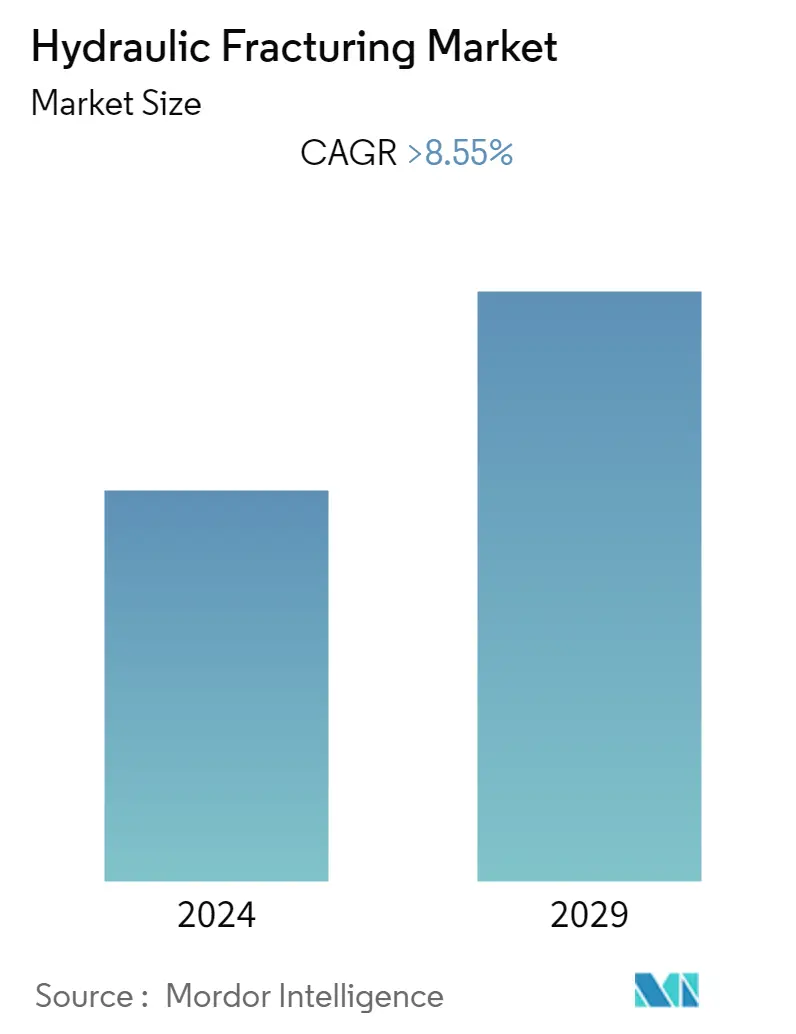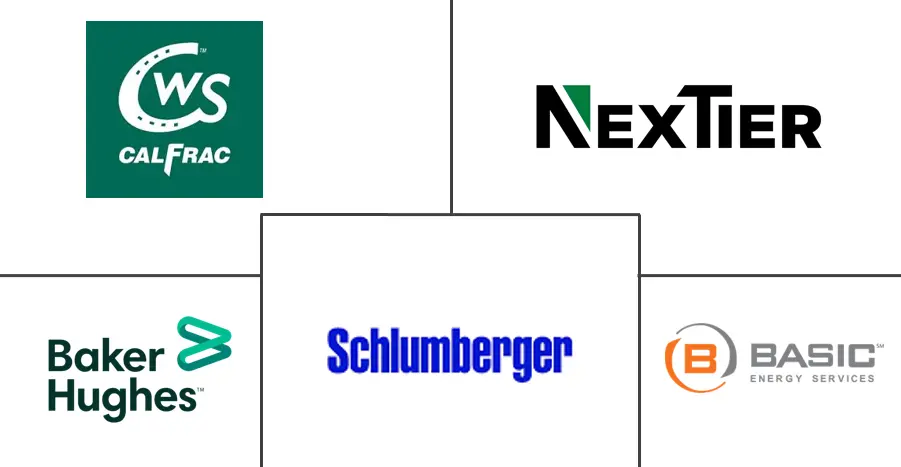Market Size of Hydraulic Fracturing Industry

| Study Period | 2020 - 2029 |
| Base Year For Estimation | 2023 |
| CAGR | 8.55 % |
| Fastest Growing Market | Asia Pacific |
| Largest Market | North America |
| Market Concentration | Low |
Major Players
*Disclaimer: Major Players sorted in no particular order |
Hydraulic Fracturing Market Analysis
The hydraulic fracturing market is expected to register a CAGR of greater than 8.55% during the forecast period of 2022 - 2027. The outbreak of the COVID-19 pandemic in Q1 of 2020 severely affected the hydraulic fracturing market. During the COVID-19 pandemic, the shale oil and gas sector suffered the most, which are among the largest sector where the different techniques of hydraulic fracturing are used. Also, the oil and gas demand slumped by more than 30 MMbbl/d in April 2020, which, in turn, affected the market. Factors, such as technological advancements with the introduction of better techniques, are likely to drive the hydraulic fracturing market during the forecast period. However, the volatility in crude oil prices is expected to restrain the growth of the hydraulic fracturing market in the coming years.
- The foam-based segment is expected to witness significant growth due to its increasing usage and rising exploration and development in global oil and gas operations.
- The advancement in hydraulic fracturing techniques and the increasing viability of vertical integration are expected to act as an opportunity for the market.
- With a significant number of oil and gas upstream projects that require hydraulic fracturing, North America is expected to dominate the market during the forecast period.
Hydraulic Fracturing Industry Segmentation
The hydraulic fracturing market report includes:
| Well Type | |
| Horizontal | |
| Vertical |
| Fluid Type | |
| Slick Water-based Fluid | |
| Foam-based Fluid | |
| Gelled Oil-based Fluid | |
| Other Base Fluids |
| Geography | |
| North America | |
| Asia-Pacific | |
| Europe | |
| South America | |
| Middle-East and Africa |
Hydraulic Fracturing Market Size Summary
The hydraulic fracturing market is poised for significant growth, driven by technological advancements and the increasing adoption of innovative techniques. Despite the challenges posed by the COVID-19 pandemic, which severely impacted the shale oil and gas sector, the market is expected to recover and expand. The introduction of foam-based fracturing fluids, which require less water and are less damaging to water-sensitive formations, is anticipated to contribute to market growth. This technique is particularly beneficial in regions with limited water resources and is gaining traction in applications such as coalbed fracturing in Canada. The demand for these advanced methods is expected to rise, supporting the market's expansion during the forecast period.
North America is projected to lead the hydraulic fracturing market, bolstered by extensive oil and gas upstream projects and new well drilling activities. The United States and Canada are key contributors, with increased drilling in the Marcellus/Utica shale and Alberta regions driving production growth. The market's development is supported by investments in new offshore projects and the redevelopment of mature fields. However, the market remains moderately fragmented, with major players like Schlumberger Limited and Baker Hughes Co. actively participating. Regulatory developments and environmental considerations are also shaping the market, with a focus on cleaner fracturing methods to mitigate environmental impact.
Hydraulic Fracturing Market Size - Table of Contents
-
1. MARKET OVERVIEW
-
1.1 Introduction
-
1.2 Market Size and Demand Forecast in USD billion, till 2027
-
1.3 Recent Trends and Developments
-
1.4 Government Policies and Regulations
-
1.5 Market Dynamics
-
1.5.1 Drivers
-
1.5.2 Restraints
-
-
1.6 Supply Chain Analysis
-
1.6.1 Bargaining Power of Suppliers
-
1.6.2 Bargaining Power of Consumers
-
1.6.3 Threat of New Entrants
-
1.6.4 Threat of Substitutes Products and Services
-
1.6.5 Intensity of Competitive Rivalry
-
-
-
2. MARKET SEGMENTATION
-
2.1 Well Type
-
2.1.1 Horizontal
-
2.1.2 Vertical
-
-
2.2 Fluid Type
-
2.2.1 Slick Water-based Fluid
-
2.2.2 Foam-based Fluid
-
2.2.3 Gelled Oil-based Fluid
-
2.2.4 Other Base Fluids
-
-
2.3 Geography
-
2.3.1 North America
-
2.3.2 Asia-Pacific
-
2.3.3 Europe
-
2.3.4 South America
-
2.3.5 Middle-East and Africa
-
-
Hydraulic Fracturing Market Size FAQs
What is the current Hydraulic Fracturing Market size?
The Hydraulic Fracturing Market is projected to register a CAGR of greater than 8.55% during the forecast period (2024-2029)
Who are the key players in Hydraulic Fracturing Market?
Schlumberger Limited, Basic Energy Services, Calfrac Well Services Ltd, Baker Hughes Co. and NexTier Oilfield Solutions Inc. are the major companies operating in the Hydraulic Fracturing Market.

